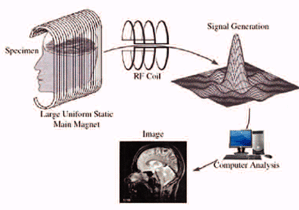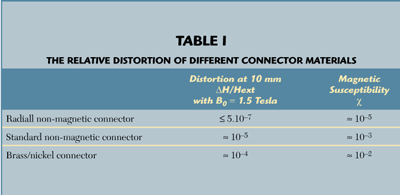
Generally speaking microwave and RF connectors tend to be viewed as simple, uncomplicated components. What is often overlooked, however, is that there are special applications requiring special connectors that have specific properties and characteristics. A prime example is Radiall’s range of non-magnetic RF coaxial connectors that have applications primarily for magnetic resonance imaging (MRI) medical equipment.
MRI is an advanced imaging technique that is able to produce high resolution cross-sectional images of the inside of the human body by exploiting radio frequency pulses. The images produced are the visual equivalent of a slice of anatomy. Although MRI has been available for over two decades, there have been tremendous technological improvements in recent years, a small part of which is due to coaxial non-magnetic connectors.
To understand why, consider that MRI medical equipment consists of a computer, a large magnet that surrounds the patient and RF coils. The magnet creates a strong uniform static magnetic field (0.3 to 7 Tesla) in a chamber where the patients lies. The transmit coil produces the RF pulse of 20 to 300 MHz, which is only aimed at the affected area. The RF pulse is responsible for altering the uniform magnetic field and generating a signal that is picked up by the receiver coil. The process is shown in Figure 1.

Fig. 1 The magnetic resonance imaging process.
The quality of the picture depends above all on the homogeneity of the magnetic field and on the signal-to-noise ratio. Figure 2 is an example of an MRI brain image with poor spatial resolution and low signal-to-noise ratio, while Figure 3 represents good spatial resolution and high signal-to-noise ratio. To avoid any interference in the field homogeneity, coaxial connectors and cables located in the magnetic field connecting the coils should be transparent relative to the field, meaning that their relative permittivity should be equal to 1.

Fig. 2 An MRI brain image with poor spatial resolution and low signal-to-noise ratio.

Fig. 3 An MRIbrain image with good spatial resolution and high signal-to-noise ratio.
Being able to meet this requirement, so called ‘non-magnetic’ coaxial connectors can provide MRI equipment with electromagnetic immunity. They are made from diamagnetic materials and plating. Such RF connectors offer a good ‘non-magnetism’ level when positioned inside the magnetic field. The field distortion they generate is so small that it meets the strict requirements of MRI type applications. Furthermore, the MRI image’s spatial resolution is optimized, adjacent image details can be captured and there are fewer corrections to be made to the image.
Connector Comparison
With standard connectors, when an external magnetic field Hext is applied, a magnetization M appears inside the material of the connector. This magnetization generates a ΔH disturbing field that distorts the flux lines of the Hext magnetic field. As a result the quality of the picture is poor and many corrections have to be made.
The disturbing field generated by the connector depends on the distance between the connector and the point where it is calculated, the connector dimensions (as the connector gets larger, ΔH increases) and the magnetic susceptibility χ of the material of the connector.
In practice, under a Hext external magnetic field, the material will get a magnetization equal to approximately
M=χHext
The weaker the magnetic susceptibility, the closer to 1 the relative permittivity mr of the material is, the more the material is transparent and the less it affects the magnetic field. So, as diamagnetic (brass, gold, silver, etc.) and paramagnetic (aluminum, palladium, etc.) materials have a magnetic susceptibility of around –10–2 to –10–9, connectors made of such materials will be transparent relative to the external magnetic field. Conversely, the greater the magnetic susceptibility the more magnetic is the material. Superparamagnetic and ferromagnetic (steel, nickel, etc.) materials fall into this category and connectors made from them will distort the flux lines of the magnetic field.
Hence, Radiall non-magnetic RF coaxial connectors are manufactured from materials specially adapted to non-magnetism — with relative permittivity close to 1 and each raw material rod being selected on a direct measurement with a vibrating magnetometer. Center contacts are gold plated over a copper underlayer and bodies are plated with BBR, a diamagnetic alloy of copper-tin-zinc or with GBR, a diamagnetic alloy of copper-tin-zinc with a thin layer of gold. Their manufacture utilizes a special production process carried out in an environment where tools are specifically allocated and where all precautions are taken to avoid any contact with ferromagnetic materials during the machining and cleaning process.
A comparison of the relative distortion of different materials is shown in Table 1. The ΔH/Hext relative distortion of a magnetic field of 1.5 T, generated by a Radiall non-magnetic connector, is only 5 10–7 maximum, at a distance of 10 mm from the surface of the connector. Moreover, these connectors meet the electrical and mechanical characteristics required for any reliable coaxial connector and also specific requirements of the medical environment such as durability. This technology is applicable for almost all of the company’s coaxial connectors, and SMB, MMCX and SMA connectors are currently available.

Space Applications
The medical market is not the only one to use non-magnetic RF coaxial connectors. They are also used in the space industry, mainly for satellites involved in scientific missions. Here, the compliance with ESA/SCC specification is a priority. Radiall has a range of SMA products, fully ESA qualified that meet the residual magnetism required by the ESCC 3402 generic specification and the ESCC 3402/001–002 & 003 detailed specifications. These connectors are made from beryllium copper, gold plated and copper underplated.
Conclusion
When incorporated in MRI equipment, Radiall non-magnetic RF coaxial connectors provide the electromagnetic immunity necessary to ensure that vital patient readings are not affected by outside magnetic distortions. To guarantee an exceptional level of non-magnetism and repeatability, each non-magnetic connector is manufactured via a strictly controlled production process and in accordance with the company’s quality assurance procedure.
Radiall,
Paris, France
+ 33 (0) 149 3535 35,
e-mail: info@radiall.com
Radiall America,
Tempe, AZ
(480) 730-5700
www.radiall.com
